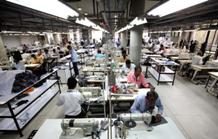MEASURES TO REVIVE MSMES
Mumbai, June 07, 2014 – The government has expressed its concerns about the massive 221% rise in sick MSMEs, with outstanding loans rising by 145%, from Rs 5,233 cr to Rs 12,800 cr, in the period between 2010 and 2013. Reforms & policy measures at Central as well as State level are required to revive MSMEs. The following measures can be taken for their revival.
Single Window Clearance
· A complex and unfriendly business ecosystem pushes small entrepreneurs towards the informal and unregistered segment, which is growing faster than the organized segment by more than five times, and already accounts for over 95 percent of all MSME. Allowing a single window clearance for MSMEs would help reduce the time, efforts, costs in getting permissions, clearances and other legal requirements while also reducing red tapism and non-compliances by MSMEs.
· The Central Government can allocate funds for the improvement of the existing district centers with good infrastructure and cadre of officers familiar with industry requirements.
· IT advancements should be used to provide single portals for clearances by different authorities.
· Some states have already made remarkable moves towards simplification of the business regulations. The other states should also be encouraged to follow the steps towards forming single window clearance systems.
Funding
· Higher government subsidies for early stage funding can be provided for start-ups in manufacturing.
· Various forms of Tax benefits can be provided on investments in unlisted enterprises as are currently provided for listed companies. This can encourage investment in form of equity in the MSMEs.
· A Credit Guarantee Fund is already set up for MSMEs. The scope of this fund can be expanded to cover various first generation enterprises by introducing additional funds.
· The returns on investments of unlisted companies can be made tax free like those in the listed companies so that the investments in both MSMEs and large enterprises are taxed at par and thus resulting in the increase in investments in MSMEs in form of equity.
· Angel Investors play an important role in scaling up the businesses making them more attractive to venture capital funds. A committee under the Chief Economic Advisor can be set up to make recommendations for removing policy and fiscal hurdles for facilitating better flow of angle investments.
Tax Benefits
· Manufacturing Entities can be encouraged by offering lower income tax rates or certain tax holidays or lower tax rates for the first few years of their operation. Countries like Japan have no corporate tax for SMEs
· Exemptions of profits or deductions of some payments/ expenses can be given on percentage basis.
· Abatements, duty drawbacks and exemptions can be granted under various indirect taxes too for MSMEs.
· Another means can be introducing deferment scheme under taxes such as excise, income tax, etc for MSMEs where the revenues of government are also protected.
· Introduction of GST can help in simplification of the tax regime and do away with the many tax returns.
Technological Upgradation
· MSMEs are facing stiff competition from imports and need technological upgradation in order to produce better quality products at cheap rates. This can be done by integrating various technologies and organizational knowledge inputs from other entities and regions.
· Product specific funds can be set up technical innovation financing investment in technology.
· Additional budget can be allocated to the Cluster development programme implemented by the ministry of MSMEs
· The MoF can consider increasing the budget allocation to Textile Upgradation Fund Scheme and Credit Linked Capital Subsidy Scheme
Support for Marketing Activities
· A portal for MSME businesses can be set up for facilitating marketing by the MSMEs.
· E-Commerce can be used to develop the marketing efficiency of these enterprises. International Marketing of the goods and services produced by MSMEs can be done that can help the MSMEs export their goods & services
· The marketing strategy of MSME products needs to take an integrated view of both the local and global markets
Labour Laws and Enforcement
India has a very heavy dose of labour legislation, their number being more than one hundred.
· There can be simplification brought in the procedural & regulatory compliance with labour laws. The MSMEs can be exempted from the definition of factory by increasing the limit of number of workers thus reducing their compliance burden.
· Trade Unions Act, 1926, The Industrial Employment (Standing Orders) Act, 1946 and the Industrial disputes Act, 1947 can be merged into a single law on Industrial relations
· Employees’ Compensation Act, 1923, Employees’ State Insurance Act, 1948; Employees Provident Fund and Miscellaneous Provisions Act, 1952 and the Maternity Benefit Act, 1961 can also be merged into a single law on Social Security so as to enable employers make a single contribution to the entire gamut of comprehensive social security cover
Reduced Intervention – Inspector Visits
· Presently each establishment is liable for inspection by several Inspectors with little or no co-ordination amongst them. There are half a dozen or so Inspectors appointed under various labour laws who make several visits to the establishment on the pretext of overseeing compliance of statutory provisions. This results in undue harassment of the enterprise.
· To the extent possible, the practice of labour inspectors inspections on regular basis can be replaced by annual inspection that is co-ordinated and organized jointly by these agencies.
Export Promotion
· Exports can be promoted by increasing the duty drawback and reducing the duties on exports.
· Various Tax Rebates can be allowed for Research and development expenses and patent filing expenses.
· Foreign Currency credit can be provided to the MSMEs for packing credit among other measures thus encouraging exports by them.
· Improved access of Indian manufacturers to global markets can be brought through effective negotiations with trade partners at the bi-lateral, pluri-lateral and WTO levels
· To facilitate international marketing, Department of Commerce/DGFT may provide an analysis on product wise export potential in different destination countries.
DEFINITIONS
MSMEs are can be in three classes both under the Manufacturing Sector & the Service Sector according to The micro, Small and Medium Enterprises Development Act, 2006:
(a) Manufacturing Enterprises: The enterprises engaged in the manufacture or production of goods pertaining to any industry specified in the first schedule to the industries (Development and regulation) Act, 1951) or employing plant and machinery in the process of value addition to the final product having a distinct name or character or use.
Defined in terms of investment in Plant & Machinery.
(b) Service Enterprises:
Defined in terms of investment in equipment.
| Manufacturing Sector | |
| Enterprises | Investment in plant & machinery |
| Micro Enterprises | Does not exceed 25 lakh rupees |
| Small Enterprises | More than 25 lakh rupees but does not exceed 5crore rupees |
| Medium Enterprises | More than 5 crore rupees but does not exceed 10 crore rupees |
| Service Sector | |
| Enterprises | Investment in equipments |
| Micro Enterprises | Does not exceed 10 lakh rupees: |
| Small Enterprises | More than 10 lakh rupees but does not exceed 2crore rupees |
| Medium Enterprises | More than 2crore rupees but does not exceed 5core rupees |
CONTRIBUTION TO THE ECONOMY:
Ø Contribute to nearly 8 percent of the country’s GDP
Ø Form 45 percent of the manufacturing output
Ø Form 40 percent of exports
Ø Provide the largest share of employment after agriculture.
Ø Widely dispersed across the country and produce a diverse range of products and services to meet the needs of the local markets, the global market and the national and international value chains.
REGULATORY BACKGROUND
The government has adopted a simple and easy structure for the setting up of new enterprises in order to promote entrepreneurship across the country. Additionally, it provides the help of specialists to budding micro, small & medium enterprises in their day-to-day functioning.
The micro, Small and Medium Enterprises Development Act, 2006
The MSMED Act, 2006 was enacted to provide for facilitating the promotion & development & enhancing competitiveness of MSMEs.
Schemes for MSMEs
The Office of Development Commissioner operates a number of schemes for the MSME sector. The ministry of MSME has also introduced various schemes & programmes for MSME for development of MSMEs, ensuring better credit availability for them, providing them with subsidies, reimbursement of certain expenses to them, providing training & research among the many others.
Industries (Development & Regulation) Act, 1951
Certain products are reserved for exclusive manufacture in small scale sector under
Section 29B of this act. These belong to the following classes:
Food & Allied Industries
Wood & Wood Products
Paper Products
Other Chemicals & Chemical Products
Glass & Ceramics
Mechanical Engg. excluding transport equipment
Reservation affords support to SSIs against competition from medium/large/ multinational companies.
ISSUES FACED BY MSMES
MSMEs including khadi and village as well as rural enterprises, play a pivotal role in the overall industrial development of the country. They have been the significant contributor to the national income, with their huge involvement in country’s industrial production, exports, etc. They not only help in providing employment opportunities to millions of people across the country, especially to the village artisans and rural people, but also check the problem of economic concentration in the hands of a few. They create a sound entrepreneurial base in the economy by developing and nurturing the talents, skills, etc. of small and medium scale entrepreneurs. The labour intensity in the MSME sector is estimated to be considerably higher than the large enterprises. Thus, this sector has been regarded a priority status by both the Central and the State Governments.
Inspite of this, the MSMEs continue to face several problems in their day-to-day operations, that is, in production and marketing of their products like:
Pricing:
MSMEs find it difficult to sell their output at remunerative prices unlike other large enterprises.
Business Promotion:
Due to limited financing MSMEs cannot spend much on advertising expenditure that is necessary for brand building. They also cannot spend more on marketing research, etc that is vital for the businesses.
Competition:
SMEs face stiff competition from large firms that possess better facilities in terms of capital, infrastructure, resources, etc easily as compared to the MSMEs.
Financing:
MSMEs are often unable to procure adequate financial resources for the purchase of machinery, equipment and raw materials as well as for meeting day-to-day expenses. The startup entrepreneurs need venture capital but since the risks are high many have to put in private capital.
Human Resource:
Further, MSMEs find it difficult to recruit and motivate skilled managerial and technical personnel. This Non availability of skilled labour at affordable cost acts as a hindrance in the development & growth of MSMEs
Inadequate Reach:
Inadequate infrastructural facilities and access to credit are other major problems. This results in low productivity.
Modernisation:
MSMEs are mostly reluctant to adopt modern methods of organisation and management. Thus resulting in not being strong enough to face completion from the large scale enterprises which adopt new methods for management & organization.































